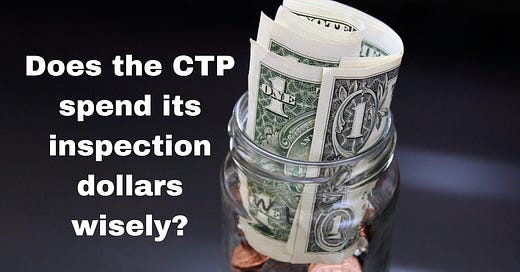The Day I Got Inspected
Due to the change in Administration, the recent layoffs of several staff, and the exploding illicit market, there has been much discussion on reforming the US Food and Drug Administration’s (FDA) Center for Tobacco Products (CTP) and/or the Tobacco Control Act (TCA).
One explanation for the rampant illicit market, provided by the CTP, is that there is an insufficient amount of time, staff, or funding for enforcement. My explanation is an unfair regulatory process that doesn’t meet consumer demand, an inequitable application of who pays user fees, and an inefficient use of time, staff, and funding to meet the requirements the CTP is tasked with effectively.
As most of my readers know, the CTP is funded by user fees paid by some manufacturers of the products it regulates. Vapes are among the many products that are exempt from user fees.
I will avoid the debate over whether the lack of user fees paid by all regulated manufacturers leads to biases influencing the CTP's actions. I will also avoid the debate over whether the CTP needs more money to afford the timely processing of PMTAs and to enforce the products it regulates.
Instead, I'll honor a request to share more stories from my days at the vape shop. I have had one experience with how CTP funds are spent, and I felt it was wasteful. Eliminating wasted funds should be part of efforts to help the FDA and CTP protect public health more effectively.
I took over my vape shop in the fall of 2018. I moved it to a new location and changed its name, keeping the previous owner's phone number for the shop. The previous owner also manufactured e-liquids for their shops, which, with my help, they continued to make for my shop.
As we approached the mad rush of the year before the deadline to submit a PMTA, the liquid manufacturer and I decided to discontinue making those liquids. Instead, we decided to devote our time to helping as many small businesses as possible submit a PMTA, even if those businesses didn’t have the time and/or funds to submit a rigorous PMTA, as would likely be needed to obtain marketing orders.
Many of you will wonder why bother submitting a PMTA if it wasn’t good enough for the CTP. That is a long story I promised Mike Cummings I would write someday. But the TL: DR version is that small businesses hoped it would buy their American companies time and raise awareness of their plight.
Given the devastating effect the process has on small businesses and the people who prefer those products, it was hoped that a change to the process would be implemented to keep as many products as possible from American companies. Alas, it didn’t happen. Instead, the CTP turned it into what felt like a flag-waving opportunity to those small businesses: “Look at us. We’re working hard. We’ve denied thousands of products.”
The closure of hundreds of businesses never made the headlines. No one cared. We failed to raise awareness that would implement change. There was no moral outrage at its devastating effect on the families who owned those businesses and the people who used those products, and no one in Congress screamed for change.
The only screaming we heard was “save the kids from the evil tobacco industry who is out to addict them.” I shall exit that rant and get back to the story…
After the PMTA submission deadline, a representative from the CTP called my vape shop to ask me about the e-liquids they mistakenly believed I was manufacturing. I informed the representative that I was the shop's new owner with a new business name and location, but I kept the old shop’s phone number. I told them I didn’t manufacture liquids, and the former owner went out of business and is no longer manufacturing. They thanked me for the information and said they would update the CTP’s records.
Fast-forward to a week before I locked the shop doors forever. The shop was full of signs notifying people that we would close at the end of the year. Signs were on the entrance door, wall, inside, and on top of each display case, and at the point of sale (POS). You couldn’t miss them.
An inspector from the CTP walked in. He introduced himself, showed me proof he was an inspector, and said he was there to inspect my manufacturing facility. I told him I was just a shop, not a manufacturer. I asked him if he had seen the signs that informed people I’d be going out of business in a week. He acknowledged he had. His records showed that the previous owner owned the shop and that it also made liquids. I pointed out that my shop had a different name and address from the prior owner and showed him my license.
The inspector said he also inspects retail locations, and even though I was closing in a week, he insisted on completing his inspection. He was very polite, but also gave me the impression I shouldn’t mess with him. I wanted to tell him to leave, but wasn’t sure I had the right to do so.
I had customers who had placed orders for extra products to tide them over after I closed. Because of this, it was one of the busiest days I had experienced in a long time. It was a heartbreaking and emotional day as I saw people for the last time—people who were like extended family, people who had counted on me to help them quit smoking and never go back to it. There were a lot of tears and hugs.
But I fear authority figures, and this tall dude in my shop represented the FDA. So even though I wanted to toss his ass out my door and shout countless obcentities at him because the FDA regulations were part of the reason I was losing my way of helping people, I meekly complied with his inspection.
He asked questions and wrote down the answers. We chatted a bit as he walked around the retail area, checked the back room, and checked the office. He took pictures of the few bottles of e-liquids still on the shelf, which had been purchased from major distributors that serve vape shops. He also took photos of the almost empty display cases.
He told me my business was the only one in Minnesota he was inspecting. If I remember right, he was from Nebraska, but regardless of the state, he wasn’t located in Minnesota.
So, the CTP paid for him to fly from his state to Minnesota, rent a car to drive three hours to my shop, cover his hotel and food expenses, and then fly him home. All to inspect a business that no longer existed, and then, because he was there, inspect a company that was permanently closing in a week.
When he landed in Minneapolis, he was in the area of e-liquid manufacturers registered with the FDA, many of whom had never been inspected. Two hours west of me was another manufacturer, and several vape shops were in my area. How is it cost-effective to send an inspector from another state to inspect only one small business when so many could have been inspected on the same trip?
As I compared notes with business owners across the US, I learned that paying for travel for one inspection of a small business in a state was a common occurrence.
As the inspector left, he thanked me for my time and expressed regret that my business was closing. He shook my hand and said I’d receive a letter from the FDA with his inspection results in a few weeks.
I never got my letter. Was that the part where cost-effective efficiency enters the story?
Until next time…
PS: In my last newsletter, I said, “At one time, people with some of my labels were locked up in institutions and never let out. There, they were subjected to horrible abuses that should never happen to a living creature. Their lives were considered an inconvenience to society. They had no value.”
One of my readers thought I was exaggerating and being dramatic. We used to have a State Hospital in my community. I know people who used to be forced to live there because they live with mental health challenges. The stories they shared about the indignities and abuse they were subjected to made me sick.
Last week was the 72nd Anniversary of the casting of the “Bell of Hope.” Please check out the link to a post explaining the bell's relevance. It is an essential reminder to not only #BeKind but also to listen to the voices of people with lived experiences. It is a painful reminder of how we used to treat people who were different, ill, and struggling.
Pushing back against misinformation:
Campaign for Tobacco-Free Kids Falsely Claims that Vaping is "Tobacco Use" - “While youth vaping should be discouraged, it is completely disingenuous to tell kids who are vaping that they are using tobacco. I support campaigns to try to prevent youth e-cigarette use, but I do not support lying to kids in order to achieve this goal.”
Events that will be discussing misinformation, misperceptions, and disinformation (Please let me know if there are more):
FDLI Annual Conference May 15-16, 2025, Washington, DC, US
E-Cigarette Summit May 19, 2025, Washington, DC, US
GFN June 19-21, 2025, Warsaw, Poland
Cheryl K Olson “…Talking with a clinician friend today, I mentioned a qualitative study that interviewed 35 doctors about e-cigarettes for smoking cessation. Five of the doctors said that no matter what current or FUTURE studies showed, they would never recommend vaping to their patients who smoked. Even if vaping worked better in randomized trials than anything else…”
Ziauddin Islam “…This poses an important question: could harm reduction strategies prioritize nicotine isolates over combustible tobacco to minimize harm while exploring therapeutic options?…”
Jeffrey Weiss “…Instead, we need a Peter Blake-like litmus test to the OSH closure and all forthcoming changes to U.S. tobacco and nicotine policy: “Will it improve public health and save lives?” If the answer is yes, we should embrace an initiative without worrying about who will profit from it.
At the end of the day, the goal of tobacco control needs to be to reduce smoking-related death and disease. A primary reason why U.S. advocacy groups have gone wrong in recent years is because they elevated the fight against industry above that of saving lives…”Sairah Salim-Sartoni “Let’s set the record straight!…”
Derek Yach “Thanks to Google Notebook I share a podcast of my recent article on the need for new approaches to research to accelerate development and acceptance of #tobaccoharmreduction if we are to end smoking. Welcome comments!” (Go to post for the link to the podcast)
Senator Babet “Isn't it crazy that it's illegal for me to buy a Zyn without a prescription?”
Sarah Jackson - (Thread) “New paper reveals two key changes in vaping trends since the UK government announced plans to ban disposable vapes…”
Jeffrey Weiss - “…Someone reading this headline or the release itself could easily come away with the belief that a new study has shown that e-cigarettes create the same cancer risk as cigarettes. That, in fact, is effectively the opposite of what the study found…This episode is an unfortunate case study of how misinformation is disseminated in the area of tobacco harm reduction.”
Cheryl K Olson “…We have a similar issue with the word "tobacco." Increasingly, "tobacco" has taken over turf formerly held by "cigarettes." Specifically, we're seeing research papers obscure the recent celebration-worthy decline in smoking - by stating that use of "tobacco " (meaning all non-medicinal nicotine products) is flat or increasing.
The deceptive implication is that the level of danger does not decline when people switch from cigarettes to nicotine pouches, or gum, or vaping. This is wrong. Nicotine addicts; it doesn't kill…”
Ending the Divide: Cliff Douglas Former American Cancer VP on Vaping, Science, and Unity.
Beyond the Buzzword: Rethinking Misinformation with Claire Wardle.
Bidi Vapor Appeals FDA's Marketing Denial Order In the 11th Circuit US Court of Appeals. “Bidi's legal counsel, Eric Gotting, contended that the FDA's denial was “arbitrary, capricious, and unlawful,” highlighting that the FDA had previously acknowledged that adult smokers of combustible cigarettes were likely to switch to Bidi's safer e-cigarettes.”
Smear Tactics Against THR Advocates Reflected in NZ Media Ruling. “Individuals and groups who receive no funding from the tobacco or vape industries may nonetheless be characterized as nefarious agents of those interests—a cheap way for opponents of THR to dismiss arguments without troubling to grapple with their merits.”
Skip Murray and the Radical Kindness. “…Because what was sold there wasn’t just vapor. It was dignity…For her, this is the only possible path: to return to nicotine users what medical and media discourse has stolen —their humanity. And to the scientific debate, what it has lost in the rush and the panic —complexity.”
All Vapes Are Flavored Vapes, Some Just Have Cigarette Flavors. “Why do we only call some vaping products "flavored"? I ask because every vaping product on the market is flavored. Those that taste like tobacco have flavor added just like those that taste like menthol or vanilla or berries. So some vaping products taste like combustible tobacco products (with either tobacco or menthol flavor) and some do not. It is possible to make unflavored vaping products, but there is no market for such products so no one does.”
In Sweden, a focus on smokeless tobacco. "“I think the main point of the Swedish approach towards tobacco nicotine products is that it would be great if a lot of people who are smoking could go straight to kale and broccoli, but in many cases, that is impossible,” said Jesper Karlsson, a Moderate member of parliament. “Ensuring that there are alternatives that are less harmful, is of course, one key component.”
The CNMC requests scientific evidence from the Ministry of Health to restrict vaping devices and nicotine pouches. “In its response, the CMNC points out that there is no European country where nicotine pouches containing less than 0.99 mg per sachet are sold and adds that the Ministry of Health does not justify, in its report or in the draft Royal Decree, "a justification explaining why the quantity in question is set."
How government taxes have fuelled the tobacco wars. “The fire quickly consumed the three-storey home. Just after 2am, while trapped inside the burning house, Tangey made a desperate call to triple-0. It was already too late. “She would have spent her final moments on her own, knowing she was going to die,” Detective Inspector Chris Murray said. “It is an unimaginable horror I hope nobody else has to experience.”
Smoking – not nicotine – is the primary cause of cancer, says leading French oncologist. “More than 64 per cent of smokers who develop cancer do not quit after their diagnosis. Dr Khayat said: “That’s why what I do and recommend now for those who don’t quit smoking is to try to reduce the harm it causes. This could potentially be achieved through alternative smoking products.”
Gold Rush: Measuring Nicotine Mortality by the Millimeter. “Ericsson slowly unravelled the string until he reached a piece of tape representing the people who die early from smoking each year. He moved his fingers down to another marker, a few meters shorter, which represented the people who die from drinking. He continued shortening the string, indicating the number of deaths by suicide (fifteen hundred), drowning (a hundred and fifty), car accidents (two hundred), and workplace accidents (between fifty and seventy)…While working on Nicorette, he and his colleagues did a risk-analysis calculation that estimated that fewer than two people per year would die of heart illnesses exacerbated by nicotine use. Compared with other hazards, he said, ‘this is not a big risk.’”
Opportunities to Reform the Food and Drug Administration’s Center for Tobacco Products. “New leadership will face significant challenges but will also have the opportunity to revisit decisions that have shifted consumption to illicit products and discouraged harm reduction—policies that, however well intended, have come at a significant cost in lives.”
Free vape kits boost smoking quits in Calderdale. “A new report has revealed that the number of people giving up smoking increased from 64% to 75% after the kits were offered during a trial funded by Yorkshire Cancer Research and delivered by Yorkshire Smokefree Calderdale.”
Why CDC cuts are being called ‘the greatest gift to tobacco industry in the last half-century’ “But as of April 1, the Office on Smoking and Health — responsible for the Tips campaign along with other projects aimed at spotting trends in tobacco use and preventing it at the national and state levels — is effectively shuttered…That’s left the future of OSH initiatives unclear, including not just the Tips campaign, which continues to air for now, but also the annual National Youth Tobacco Survey… States and U.S. territories, which received the bulk of OSH’s $240 million in funding, relied on the agency’s support to run quit hotlines…OSH was also responsible for Surgeon General’s reports on tobacco use, which in recent years had focused on topics like health disparities in tobacco-related disease and death, smoking cessation, and e-cigarette use among young people.”
Utahns cross state lines to buy flavored vape products after statewide ban. “Over the course of 10 minutes on Monday afternoon at the Juicity Vapor shop in Evanston, Wyoming, three cars with Utah license plates pulled into the parking lot. They were filled with people from Weber County, Utah County, and Sanpete County. They were all in Wyoming for one reason: flavored vape products.”
CAPHRA Condemns WHO’s Outdated Tobacco Reporting. “While WHO bureaucrats recycle outdated tactics, 1.3 million people in Southeast Asia and the Western Pacific die annually from smoking-related illnesses. These are preventable tragedies, not inevitable statistics. The 2025 report must abandon moral posturing and embrace evidence-based strategies that actually work.”
Greece: Flavour Ban Threatens Public Health Progress. “Since 2019, when Greece officially adopted harm reduction as a core pillar of its tobacco control policy, the country has reversed the previously growing trend of smoking—a stark contrast to the stagnation seen across much of the EU.”
Smoke-free surge stalled by feds clinging to old habits. “Despite the flood of misinformation, the market is succeeding where decades of public health campaigns have failed: It’s making cigarettes obsolete. Given the choice, consumers are ditching smoke for safer alternatives that deliver nicotine without combustion’s deadly byproducts. This isn’t just progress — it’s a landmark victory for harm reduction.”
Safer But Unavailable: Why Are Nicotine Pouches And Vapes Out Of Reach For African Smokers? “In much of Africa, a smoker trying to quit has only one readily available option: quit cold turkey or die trying. The irony? Safer alternatives like nicotine pouches and vaping devices, which have helped millions quit smoking globally, are either banned, priced out of reach, or simply unavailable across the continent.”
More news:
MPOWER / FCTC Plus: Embracing THR. “Excluding THR proponents entrenches a one-size-fits-all approach, ignoring regional realities where smoking rates soar. A more inclusive model, like the WHO’s Framework for Engagement with Non-State Actors, could integrate independent THR voices under transparent conditions, ensuring evidence-based policies without industry capture. The FCTC’s outdated MPOWER measures, focused solely on demand reduction, must evolve to embrace Article 1(d)’s endorsement of harm reduction.”
Final thoughts…
Thank you, Ken Warner and Karl Erik Lund, for your kindness.
Thank you to the organizers, speakers, and attendees of ATNF. It was a wonderful week, and I appreciate the warm reception given to the voices of those who use nicotine.
Notes:
I create these newsletters as a personal project. They are not affiliated with any current or past employers or groups I do volunteer work with. I receive no financial compensation for my efforts to create these newsletters.
My blog, Skip's Corner, has an X/Twitter account. My personal accounts are on BlueSky, LinkedIn, and X (Twitter).














